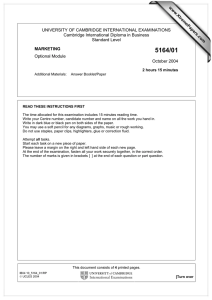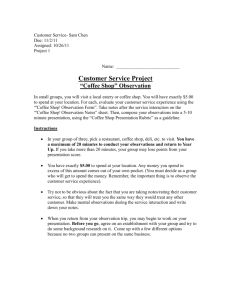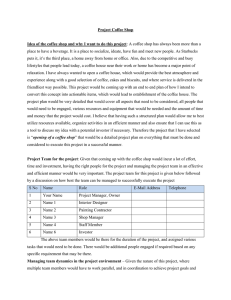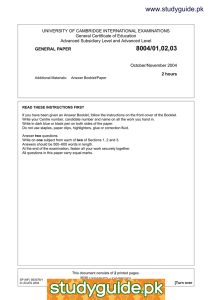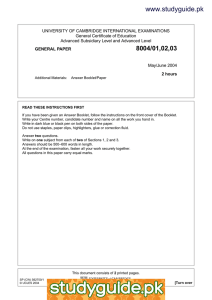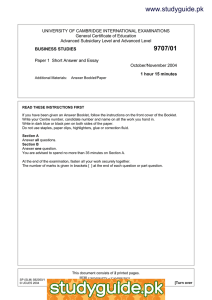www.studyguide.pk
advertisement
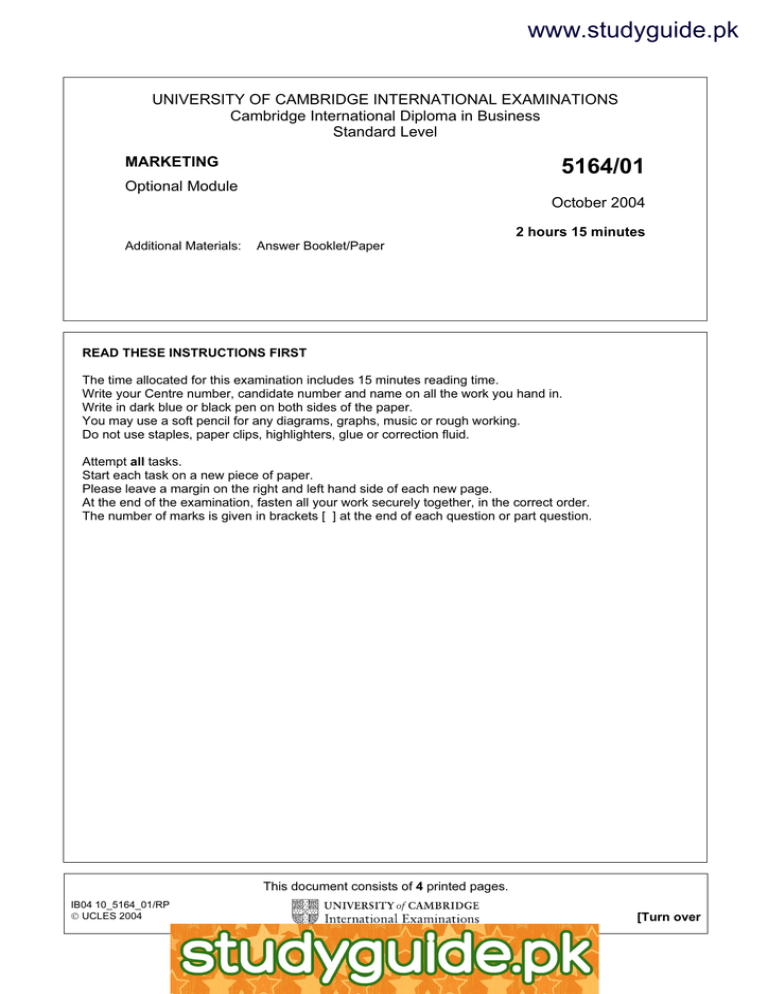
www.studyguide.pk UNIVERSITY OF CAMBRIDGE INTERNATIONAL EXAMINATIONS Cambridge International Diploma in Business Standard Level 5164/01 MARKETING Optional Module October 2004 2 hours 15 minutes Additional Materials: Answer Booklet/Paper READ THESE INSTRUCTIONS FIRST The time allocated for this examination includes 15 minutes reading time. Write your Centre number, candidate number and name on all the work you hand in. Write in dark blue or black pen on both sides of the paper. You may use a soft pencil for any diagrams, graphs, music or rough working. Do not use staples, paper clips, highlighters, glue or correction fluid. Attempt all tasks. Start each task on a new piece of paper. Please leave a margin on the right and left hand side of each new page. At the end of the examination, fasten all your work securely together, in the correct order. The number of marks is given in brackets [ ] at the end of each question or part question. This document consists of 4 printed pages. IB04 10_5164_01/RP UCLES 2004 [Turn over www.xtremepapers.net www.studyguide.pk 2 You must read the case study below and attempt all the tasks which follow. [The following case study is fictitious] ‘THE COFFEE SHOP’ The traditional coffee shop is seen everywhere in Asia, but its future is in question. Such shops are usually without air-conditioning. They consist of various stalls offering food and drink such as noodles, mixed-foods, chicken rice or Indian roti. The drinks stalls usually sell hot and cold beverages such as coffee, tea, and fruit juices, and also often sell bread, eggs, snacks and 5 cigarettes. Each stall is normally operated by an independent stallholder, who competes with the other stallholders for the customers that patronise the coffee shop. Usually the individual stallholders are responsible for cleaning up after their customers. Sometimes the stallholders combine their resources and hire a contractor to carry out the cleaning up. The stallholders are self-employed and share all major overheads. Many have been in business for years, but do little or no marketing 10 for their businesses. In recent years, alternatives to the traditional coffee shop have become much more diverse and readily available. Fast food outlets such as McDonalds represent just one of these competitors. Others include Food Courts in major shopping malls, cafés and coffee bars. These alternative food and beverage outlets are normally air-conditioned, attractively decorated, and employ well- 15 trained, cheerful staff. They provide strong competition to the traditional coffee shop. George Leong has had two stalls in a local Coffee Shop in Singapore for twelve years, and wants to continue in business for another twelve years before he retires. He would like to sell on his business to give him money for his retirement. He has been watching the opening of fast-food outlets with interest, and believes that he can learn some lessons from the way they operate. He 20 often visits different competitors and has a cup of coffee on his way to or from work, and has noticed many differences between them. George would like to make improvements within his Coffee Shop, but does not know where to start. He has asked you for your advice, as he is aware that you have been studying marketing at 25 college. UCLES 2004 5164/O/04 www.xtremepapers.net www.studyguide.pk 3 You must attempt ALL of the following tasks 1 (a) Write a definition of marketing for George to explain what marketing means. [5] (b) Explain, using examples relevant to the Case Study, the meaning of the following terms: (i) marketing research (ii) market segmentation (iii) marketing plan (iv) marketing mix (v) market share 2 [5 x 3] [Total: 20] (a) George has been carrying out a recognised method of primary research. Identify the method he has been using, and explain what is involved. [5] (b) You have recommended that George carry out further primary research to identify his customers’ needs. Explain and identify different data collection methods for the following types of research: (i) customer survey [5] (ii) customer focus group [5] (iii) customer interview 3 4 [5] [Total: 20] (a) Explain two different methods that a coffee shop might use to segment its market. [2 x 5] (b) Explain five advantages that segmenting the market would offer to a coffee shop. [5 x 2] [Total: 20] George has asked you to put together a marketing plan for him, to help the Coffee Shop stay in business. (a) Identify one strength, one weakness, one opportunity and one threat that would be included in a SWOT analysis for the marketing plan. [8] (b) Give two reasons why it is important for George to continue to monitor competitor activity on a regular basis. [4] (c) Explain why it is important to review progress to a plan on a regular basis, and how SMART objectives help you to do this. [8] [Total: 20] UCLES 2004 5164/O/04 www.xtremepapers.net [Turn over www.studyguide.pk 4 5 Suggest actions that a coffee shop might take under the following four elements of the marketing mix: (a) Product/service [5] (b) Promotion [5] (c) People [5] (d) Physical evidence [5] [Total: 20] University of Cambridge International Examinations is part of the University of Cambridge Local Examinations Syndicate (UCLES), which is itself a department of the University of Cambridge. UCLES 2004 5164/O/04 www.xtremepapers.net
